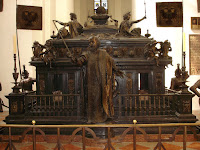Another thing it turns out I'm ignorant about (although I might have suspected it) is the short-lived but spectacular flowering of cast-bronze sculpture in southern Germany around 1600. This took place mainly in Munich, seat of the Wittelsbach princes, and Augsburg, home of the HNW Fuggers - no coincidence, since casting large-scale sculptures is bronze is enormously expensive. The 'Neptune ...taming a sea-horse...which Claus of Innsbruck cast in bronze for me' that the speaker of Robert Browning's 'My Last Duchess' draws his guest's attention towards is supposed to speak loudly about his spending-power. It's also a quiet reminder of a river of artistic influence on which bronze deities of all sorts flowed between northern Italians states and southern German ones as the 16th century drew to a close.
At the head of this river was a Dutchman, usually known by the less than compellingly Dutch name Giambologna (French Jean de Boulogne). A portrait of him by Hendrick Goltzius (more convincing Dutch name) is above, partly so that he'll stand at the head of a river of images in this post. And partly as a thanks for leading, directly or indirectly, to the flood of monumental bronzes that visitors to Munich can now wade into.
There's at least one weighty tome on this topic by others who know vastly more about it than I do. So instead of trying to write anything much about it, here's a quick intro in images.
Let's start with two works by Giambologna himself, both on classical themes: the Rape of the Sabines (1574-82) and Hercules and Nessus (1599), both now in the Loggia dei Lanzi in Florence.
At the head of this river was a Dutchman, usually known by the less than compellingly Dutch name Giambologna (French Jean de Boulogne). A portrait of him by Hendrick Goltzius (more convincing Dutch name) is above, partly so that he'll stand at the head of a river of images in this post. And partly as a thanks for leading, directly or indirectly, to the flood of monumental bronzes that visitors to Munich can now wade into.
There's at least one weighty tome on this topic by others who know vastly more about it than I do. So instead of trying to write anything much about it, here's a quick intro in images.
Let's start with two works by Giambologna himself, both on classical themes: the Rape of the Sabines (1574-82) and Hercules and Nessus (1599), both now in the Loggia dei Lanzi in Florence.
Literal tonnes of smaller bronze versions of these are around (including in a room in the Bayerisches Staatsmuseum in which my personal rediscovery of Johnny Baloney was made). Some are better than others; here are two chosen at random:
One bronze in Munich that is by Giambologna himself is the towering crucifix in Michaelskirche, a gift to the Wittelsbachs by their fellow jet-setters the Medici. There was a connection there, with Albrecht V of Bavaria's sister-in-law marrying Francesco de Medici in 1565. And, of course, their wedding forged a link in the bronze-casting chain, with Hubert Gerhard, a student of Giambologna, going on to work for both the Fuggers in Augsburg and the Wittelsbachs in Munich. Here are two examples of his efforts, the archangel Michael defeating Lucifer on the facade of the Michaelskirche, and Perseus holding up the head of Medusa (this one in the Wittelsbachs' Residenz palace in Munich):
Soon the Wittelsbachs decided to breed their own sculptors by sending talented sons of Bayern to Florence. Two of the most successful of the new crop were Hanses Reichle and Krumper. Here's another Michael by the one Hans, above the entrance to the Zeughaus in Augsburg; and the tomb monument of the Holy Roman Emperor Louis IV (a Wittelsbach) by the other Hans, in the Munich Frauenkirche:
I've saved probably the most recognizable of Giambologna's works for last, the Flying Mercury from around 1580. This one has been extensively copied and played off, and has turned up all over Europe - including, of course, in the Wittlesbach's home in Munich. What better image of the swiftness and borderlessness of artistic influence could there be?










No comments:
Post a Comment